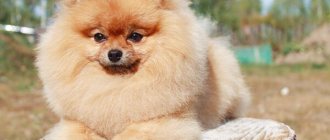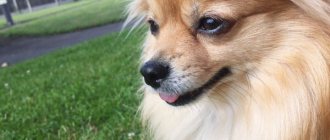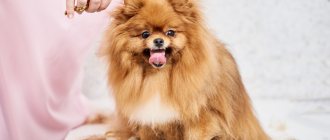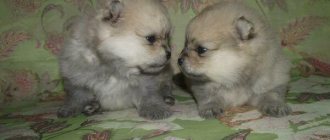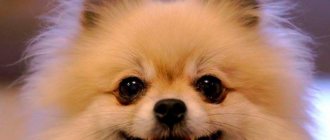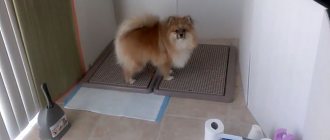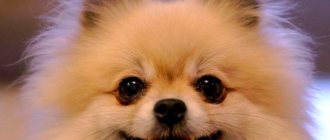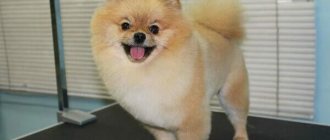When choosing a Miniature Spitz, they first look at their charming appearance, then at their lively and cheerful character. Against their background, the negative aspects fade, it seems that they are not significant, and they are easy to cope with.
However, we should not forget about the negative sides of the dog. Before getting a pet, weigh the pros and cons of a Pomeranian. This is the only way these charming “fox cubs” will not disappoint their new owners, and they will raise a happy dog.
Breed traits
Breed traits (on a 5-point scale)
| Pomeranian Spitz | |||
| Activity | in the house | 3.4 | |
| on the street | 3.4 | ||
| Obedience | training | 3.6 | |
| strangers | 3.6 | ||
| Domination | in family | 1.4 | |
| over dogs | 2.5 | ||
| Defending your territory | from people | 2 | |
| from dogs | 2.8 | ||
| Sociability | in family | 4.6 | |
| with strangers | 3.9 | ||
| with dogs | 3.6 | ||
| Concentration | in family | 1.6 | |
| in front of strangers | 1.9 | ||
| with dogs | 1.9 | ||
| Aggressiveness | in family | 1.5 | |
| to strangers | 1.8 | ||
| to the dogs | 2.1 | ||
| to cats | 2.3 | ||
| Family behavior | calmness | 4.2 | |
| demand for affection | 4.3 | ||
| excitability | 4.1 | ||
| playfulness | 4.1 | ||
| excessive barking | 3.5 | ||
| behavioral breakdowns | 1.9 | ||
| Tolerance for children | up to 4 years | 3.1 | |
| over 4 years old | 3.8 | ||
| Institutional use | watchman | 4.3 | |
| bodyguard | 1.7 | ||
This breed is often compared to the following dog breeds: Chihuahua, Pug, Maltese (Maltese Bichon), Papillon, Bichon Frize.
Pomeranian Spitz
Pomeranian Spitz
Features of temperament
Spitz dogs have a cheerful disposition and are energetic and cheerful. And such a temperament can be considered an undoubted advantage if the family has children who happily run around the house with a wind-up pet. Or the Spitz owner is active and does not like to sit still for a long time, preferring to spend time in constant movement. The breed may not be suitable for calm and measured people, as overflowing emotions disrupt the leisurely rhythm of life. Reserved owners should pay attention to more phlegmatic dogs.
The emotionality of the Spitz deserves special words; it can be considered the calling card of the breed. Dogs express all feelings, be it joy, fear or impatience, in all available ways. But most often with the help of barking, and this is a rather significant drawback. The phone rang? Your friend will be happy to duplicate the call so that you can hear it accurately. Did a dog bark outside the window? The Spitz will definitely make itself known and support its brother. Did there thunder or fireworks? The vigilant pet will not miss this event and will loudly support any event.
To be fair, it is worth noting that not all Spitz barks all the time. If there is only one dog living in the house, there will be practically no noise from it for no reason. It is important to take into account that male dogs bark many times more, as they take a very responsible approach to protecting their owner’s property. Pomeranians love to bark in a large group, so the problem of excessive barking affects those owners who have several representatives of the breed in their home.
General characteristics of the Spitz breed
The Pomeranian Spitz is a devoted companion that easily finds a common language with any owner. A faithful friend for an adult, an active playmate for children. This dog is easy to distinguish from others: a sharp, seemingly smiling face, cheerful, inquisitive eyes, a fluffy fur coat, and a ringing bark. The best pet to keep in an apartment. In size and habits it resembles a cat, and in appearance it resembles a fox or a bear.
Descended from ancient wolf breeds, it is a subspecies of the dwarf German Spitz. This dog is hardy, active, and is used as a companion and watchdog. Gets along well with other pets and loves children. The Pomeranian is suitable for active people, as it needs long walks. He is capable of becoming a family favorite, and his funny appearance attracts the attention of others.
| Options | Characteristic |
| country of origin | Germany |
| purpose of the breed | decorative, companion |
| height | 18-24 cm |
| weight | 1.5-3.5 kg |
| life expectancy | 14-16 years old |
| aggressiveness | not aggressive, friendly |
| activity | average |
| intelligence | standard |
| training | uncomplicated |
| attitude towards loneliness | can't stand it |
| need for care | average |
| security qualities | average |
Pros of the breed
The Pomeranian Spitz is a popular dog, suitable for keeping in an apartment, for families with children. These pets have many advantages:
- cute appearance of a funny bear;
- cheerful, cheerful character;
- they are sociable, playful, ready to support any fun;
- loyal, adapt to the owner’s mood, love all family members;
- fearless, bravely protect their owners from any threats;
- easy to train, able to learn any commands, learn any tricks;
- clean, lick themselves, don’t smell like dogs;
- unpretentious, easily get along in any conditions;
- unobtrusive, adapt to the lifestyle of their owners;
- thick wool protects the dog from cold and heat;
- due to its small size, it can be kept in a small apartment;
- suitable for inexperienced owners, single people, families with children;
- Bear-type Pomeranians have good health.
Minuses
Despite their slightly doll-like cute appearance, these dogs are not for everyone. The disadvantages of the breed often include difficulties in maintaining and raising the Pomeranian. They also have other disadvantages:
- these little bears are quickly excitable, emotional and impulsive;
- often get into fights with other dogs;
- they love to bark, have a very loud voice, and are difficult to calm down;
- may show aggression towards strangers;
- Sheds a lot and is difficult to care for;
- tend to dominate, so strict education is required;
- They are very active, energetic; without sufficient physical activity, interior items and belongings may be damaged.
An interesting video will tell you about the advantages and disadvantages of dogs of this breed:
"Galatiness"
Pomeranians are very sociable, so the barking will not stop all day long. For an animal, this is the main way of expressing its feelings and spiritual breadth. In modern high-rise buildings with their thin walls without sound insulation, the sonorous voice of the orange can be heard throughout all floors.
Easily excitable and too impulsive, little “bears” have difficulty responding to calm. It is important to train your Spitz correctly in order to correct this point.
History of the origin of the breed
The Pomeranian is the smallest Spitz. This breed has been known since ancient times. In Europe, back in the Stone Age, there lived turf dogs, similar to modern Spitz dogs. They were large, strong, unpretentious. In the Middle Ages, these dogs were used as mounts and guards. In the 18th century, one of the small Spitz dogs came to Great Britain to Queen Charlotte. She liked the dog and became popular among the nobility.
At first these dogs were larger, weighing about 9 kg. But dog breeders tried to breed dwarf representatives of the breed. In the 19th century, selection began, the smallest individuals were selected. They had a flattened muzzle and fluffy fur. Back then these dogs were called miniature Spitz dogs. At the end of the 19th century, the new breed was officially recognized. Since such dogs were first brought from the German province of Pomerania, they were called Pomeranian Spitz.
The fashion for such miniature dogs has spread throughout Europe. They were bred by noble ladies as indoor decorative pets. White Pomeranians, the larger representatives of the breed, were popular back then. At the beginning of the 20th century, Spitz came to the United States. Amateur clubs appeared, and a breed standard was adopted.
Due to World War II, the breed almost disappeared. Its revival began in the 90s of the 20th century. An updated standard was adopted, according to which the dog should weigh 2-3 kg, height 18-22 cm. Mini varieties are not recognized by the standard, since they cannot participate in breeding.
Who would like a charming baby?
A cheerful, playful, funny Pomeranian is suitable for those who need “bright rainbows” among gray everyday life. This little miracle can change your mood in an instant and give selfless love and devotion. But you have to pay for everything: the dog cannot stand loneliness, loves long walks and fun activities. He also constantly strives to dominate, to become the “king of the hill.” A patient, persistent, and sometimes demanding owner is able to give the dog the right education and make its life happy.
Appearance of Spitz dogs
Pomeranian Spitz belong to the breeds of the primitive type, part of the European Spitz section. According to standards, the height at the withers is equal to the body length and is 18-22 cm. Weight is up to 3.2 kg. Exhibition representatives of the breed weigh 2 kg. Mini Spitz have a weight of 1.5-2 kg and a height of up to 18 cm.
Head
The head is medium in size, round, wedge-shaped. The forehead is rounded, the stop is clearly defined, the cheekbones are not visible. The muzzle is narrow and short. Scissor bite, cheekbones not prominent. The chin is slightly raised and the lips are pressed tightly together. The nose is small, upturned, black, but in red individuals it can be brown.
The eyes are round, small, and located close to each other. The eyelids are black, the look is cheerful, intelligent. The ears are triangular, pointed, small, set close and high.
Body type
The physique is muscular, dense, square in shape. But the dog carries himself with grace and grace. The neck is strong, slightly arched, covered with hair, which forms a luxurious collar. No suspension is formed. The chest is deep, the stomach is tucked. The back and croup are short. The tail is of medium length, set high. He bends into a ring and lies on his back.
Limbs
The limbs are straight and parallel. The front ones are set wide apart and muscular. The hind legs are densely covered with hair. The paws are small, round, gathered into a ball. The pads are hard. The dog moves elastically, freely, springily.
The photo shows what a Pomeranian Spitz looks like according to the standard:
Appearance of a Pomeranian Spitz
Pomeranian Spitz - appearance
Coat and color
The coat is long, with a thick soft undercoat. On the legs, head, ears it is quite short and protruding. On the body it is straight, 5-6 cm long. On the neck and shoulders there is a thick collar resembling a mane. The hind legs have fluffy pants, the tail is well furred. Such a thick coat is only formed in adult Pomeranians by the age of 3 years.
The standard allows several colors. Often puppies born with the same coat color change it as adults. The final color is established after the guard hair grows.
- The most popular are orange or golden-red Spitz. They resemble little foxes. The intensity of color on different parts of the body may be heterogeneous.
- Black Pomeranians are common. Their coat is varnish-shiny, without inclusions of other colors.
- The chocolate color should be rich and dark. These dogs' noses, lips and eyelids may also be brown.
- The white color of Pomeranians should be uniform, without spots of a different color.
- Wolf or gray-sable. The silvery fur is black at the tips. The head is darker than the body.
Less common are cream, black and tan, and sable. The standard allows the presence of spots located symmetrically. For such dogs, the main color should be white. The pure black and brown Spitz looks like a bear cub. Blue, chocolate and tan, brindle colors are not recognized by the standard.
It has been noticed that the color of the orange's fur determines its quality. Cream-colored individuals have the fluffiest and softest fur. Red ones have less hair, while black ones have coarser hair.
Varieties
There are several varieties of Pomeranian Spitz. The differences between them are little noticeable. The phenotype depends on heredity and may appear over a generation. It is finally formed after a year.
- Standard Pomeranian with a fox face. He has round eyes and a small nose.
- The bear-type Pomeranian is more popular. Its muzzle is shorter, its head is round, and its lower jaw is wide. This bear differs from others in having an upturned nose, a lot of fur on its cheeks, and small ears.
- Puppet type with an almost flat muzzle. The forehead is wide, the eyes are deep-set.
The differences between the different types are only in the shape of the muzzle. The rest of their breed characteristics are the same. There is also a mini variety, 16-18 cm tall, weight 1.5-2 kg.
Photos of different colors and types of representatives of the breed show the differences between them:
Fox Nose Pomeranian
Bear-type Pomeranian
Pomeranian doll type
Disqualifying faults
If Spitz dogs exhibit deviations from the standard, they are not allowed to breed and show. Some of them are noticeable only in adult dogs. There may be the following disadvantages:
- snack or undershot;
- white spots with dark color;
- strongly convex or flat skull;
- very sharp muzzle or sharp stop;
- light eyes or nose;
- bulging eyes, everted eyelids;
- semi-erect ears;
- deviations from height and weight standards.
Breeding Miniature Spitz
Bitches of this breed begin to go into heat at about one year of age, but breeding cannot be done right away. Only after the dog reaches 2 years old can you plan to have offspring. Males are bred at 18 months. Bitches come into heat twice a year and last up to 22 days. Before mating, it is imperative to show the animals to a veterinarian.
Dogs are bred after they reach two years of age.
If the bitch is sick, weakened or has signs of obesity, it is better to wait a little while getting offspring. The gestation period for this breed is 63 days. If labor begins on day 57 or earlier, there is a high probability of stillbirth. There can be from 1 to 3 puppies in a litter. During pregnancy, the bitch must be protected from jumping from high heights, hypothermia, blows, etc. In addition, she requires high-quality nutrition.
Due to the small size of Pomeranians, childbirth often occurs with complications. The owner of a bitch needs to be prepared for the fact that the dog will need to be urgently taken to the clinic for a cesarean section. Severe complications occur especially often during the first birth. It is advisable to let the bitch eat the afterbirth, because... this will help normalize her condition and increase her immunity.
The muzzles of newborn puppies should be freed from the amniotic sac. They need to be held upside down so that fluid comes out of the respiratory tract.
Character of Pomeranian Spitz
The Pomeranian is a devoted friend and brave protector. From his ancestors - German Spitz - he inherited courage, endurance, and energy. These dogs are curious, always on the move and exploring the world around them. They need the opportunity to run around and burn off energy, so walks should be active, with active games.
The Pomeranian becomes very attached to its owner and senses his mood. If they don't pay attention to him, he will be sad. The dog is ready to accompany the owner everywhere, support him in any games, amuse him and express his joy with a ringing bark. She can attract the owner's attention in different ways. This pet loves all family members, but becomes attached to only one, and is very sad in his absence.
Pomeranians are characterized by the following qualities:
- activity;
- good nature;
- devotion;
- curiosity;
- sociability;
- agreeableness;
- cleanliness;
- intelligence;
- cockiness;
- restlessness.
The Pomeranian Spitz is wary of strangers. Although he does not show aggression, he does not allow himself to be touched. And if threatened, it can attack and bite. Gets along well with children and pets if he grew up with them. Due to the hunting instinct, it is undesirable to keep Pomeranians in the same house with birds and rodents
Education and training
Pomeranians are very intelligent for a toy breed. Their intelligence and intelligence were inherited from their ancestors who served man. And now these little dogs can work in the police or rescue service, guard the house or clear the area of rats.
They are able to learn any commands and skills. But they are best at those that require a lot of movement. The commands “fetch” and “fetch” are especially easy to learn; they can learn agility, freestyle, and frisbee.
You need to start training your pet as early as possible. Spitz dogs strive for dominance and can be stubborn, so you need to immediately show your pet who’s boss. In the first six months of life, the dog must learn the rules of behavior in the house and on the street, understand the commands “no”, “come to me”, “place”, “sit”, “stand”, “near”, “fu”. It is important to teach your Pomeranian not to bark constantly, especially if he lives in an apartment building.
Education should be consistent, persistent, but gentle. Physical punishment should not be used; in response to such an attitude, he may become capricious and aggressive. It is better to interest the Pomeranian and reward him for correct behavior with affection or a treat.
Owner reviews
Reviews from Pomeranian owners, which can be read on various Internet forums, usually sound positive. People adore their pets because they are cute, kind, affectionate, and optimistic. They are valued for their loyalty and ability to become a friend. They note their intelligence and playfulness. They are proud of their beauty: “Passers on the street turn to look at us!”
When asked to name the disadvantages of the breed, Pomeranian owners most often answer that there are none, except perhaps the high price that breeders ask for a puppy. However, some owners are upset by their pets’ habit of barking a lot, being offended by other family members, and behaving badly as a sign of resentment.
Maintenance and care
The Pomeranian Spitz is a fairly unpretentious pet that adapts to any living conditions. Thanks to its thick coat, it does not freeze in winter and easily tolerates summer heat. But due to the short muzzle, heat exchange in these dogs is poor. Therefore, you cannot keep them outside; the Pomeranian is an indoor pet. You can toilet train at home using a diaper. But you still need to take him outside to run for at least an hour a day.
Apart from grooming, other hygiene procedures are the same as for other dogs:
- brush your teeth once a week and give chewing bones;
- check and wipe your eyes and ears daily;
- Trim nails monthly.
Grooming
The thick, long coat of Pomeranians needs to be brushed well every few days. This will prevent the formation of tangles. To remove dead hairs, the comb movements should be directed against the hair.
You should not often bathe your Pomeranian. His skin is prone to dryness and allergies. It is recommended to completely wash it only if it is heavily soiled, or after shedding. Be sure to use a special shampoo and conditioner. After a walk, you can wash your paws and belly, and if necessary, wipe the fur with a damp towel.
Many owners give their pets haircuts. When the fur is short, it is easier to care for, and the fluffy bear turns into a fun plush toy. But experts do not recommend cutting these dogs short. Because of this, the structure of the coat may be disrupted, it begins to fall out, and the guard hair disappears.
It is better to entrust a dog that participates in exhibitions to a groomer. He will do the right haircut, trimming the ends, and remove hair from the ears, butt, and paws. It is recommended to bathe your pet before the exhibition.
The photo shows how oranges change after a haircut:
Pomeranian Spitz after haircut
Puppet type. Spitz after haircut
Pomeranian Spitz before and after haircut. Teddy Bear
Feeding
Pomeranians are dogs that love to eat and are prone to gaining excess weight. Therefore, it is better to choose dry food intended for this breed. It contains all essential nutrients balanced. Super premium food for small breeds is also suitable. Do not exceed the dosage recommended on the packaging. Usually this is about 100 g at a time.
If you feed your Spitz natural food, you need to give him the following foods:
- boiled lean meat at least 30% of the diet;
- porridge – buckwheat, rice – up to 10%;
- dairy products;
- sea fish, eggs – once a week;
- boiled vegetables.
With this feeding, additional vitamin supplements must be given. Fatty meats, river fish, smoked meats, potatoes, legumes, onions, baked goods, and sweets are contraindicated. Pomeranians require 200-250 g of food per day, so this type of food is inexpensive.
Health
If you feed your orange correctly and provide it with sufficient exercise, health problems will not arise. These dogs are long-lived, they can live 16-18 years. You only need to give an anthelmintic every 3 months, regularly treat against parasites in the warm season and do all the necessary vaccinations.
This is a strong, hardy and efficient dog. Sometimes the following health problems occur:
- dental problems;
- eye pathologies, lacrimation;
- pathologies of the skeletal system, joint dislocations;
- diseases of the digestive tract;
- hypothyroidism
Bear type dogs have a fast metabolism. They get sick more often; if you feel unwell, you should immediately contact a veterinarian. Mini varieties are not recommended for breeding. They are weak and painful.
How to buy a puppy
It is difficult to determine from Pomeranian puppies what they will be like when they grow up. Breed characteristics such as a fox or bear face or color appear only by 4 months. Although coat color may change after shedding, it is recommended to buy a puppy after 4 months.
To do this, you need to choose a good nursery or a responsible breeder. Due to the popularity of the mini varieties, these dogs are sometimes bred without paying attention to health and compliance with the standard.
A purebred Pomeranian cannot be cheap. In Moscow, the price of a puppy starts from 30 thousand rubles. If a Pomeranian is offered inexpensively, you need to be wary: either he is undocumented or has developmental defects. Without a pedigree, such a dog can be bought for 15-30 thousand. You just need to study the reputation of the breeder and the living conditions of the animals.
When choosing a pet, it is recommended to watch the babies, pick them up and examine them. A healthy puppy should have:
- black wet nose;
- clean eyes and ears without an unpleasant odor;
- thick soft wool without dandruff and bald spots;
- the paws are straight, the belly is not bloated, the back does not sag;
- lively, playful mood;
- lack of aggression or cowardice.
You should not pay attention to the size and color; they can change with age. It is imperative that a puppy, even one without a pedigree, must have a veterinary passport and all vaccinations appropriate for its age.
The photographs show what Spitz puppies should look like:
Pomeranian puppy
Pomeranian puppies
Puppies
Another interesting video will help you form a final impression about these dogs:
The Pomeranian is an amazing dog with an unusual appearance and luxurious coat. But this pet is not suitable for everyone. It is not advisable to get one for those who do not have time to walk the dog, play with it, or pay attention to it. But this cheerful, cute dog is able to brighten up loneliness and keep a child or an elderly person company. He will become a devoted friend and vigilant protector.
Weaknesses of bitter orange
Pomeranian Spitz owners point out several possible problems that can hardly be called defects of the breed. Rather, these are disadvantages caused by the characteristics of the fluffy dog:
- Wool "throughout the region." If you brush your dog on time and thoroughly, there won’t be any special problems with grooming. The dog actively sheds only during the season (spring). During this period, the animal will need to be combed daily.
- Teeth. The period of changing teeth is difficult for both the owner and the dog. Baby teeth often have long roots; they refuse to fall out and give way to permanent teeth. The result is an uneven bite. If this happens, you will need to contact your veterinarian.
- Bark. Oranges are very talkative. They bark with or without a reason, just from the depths of their souls. But with proper training, this disadvantage is eliminated quite quickly.
- The desire to dominate. This character trait needs to be eradicated from day one. You cannot even allow the puppy to feel like the “leader of the pack” for even a minute.
A purebred and vaccinated dog usually does not cause problems, but the owners have to go through a difficult stage of education and “pumping up” their characters. As soon as the child recognizes the person as the main one, he will become an affectionate, obedient and cheerful companion.
